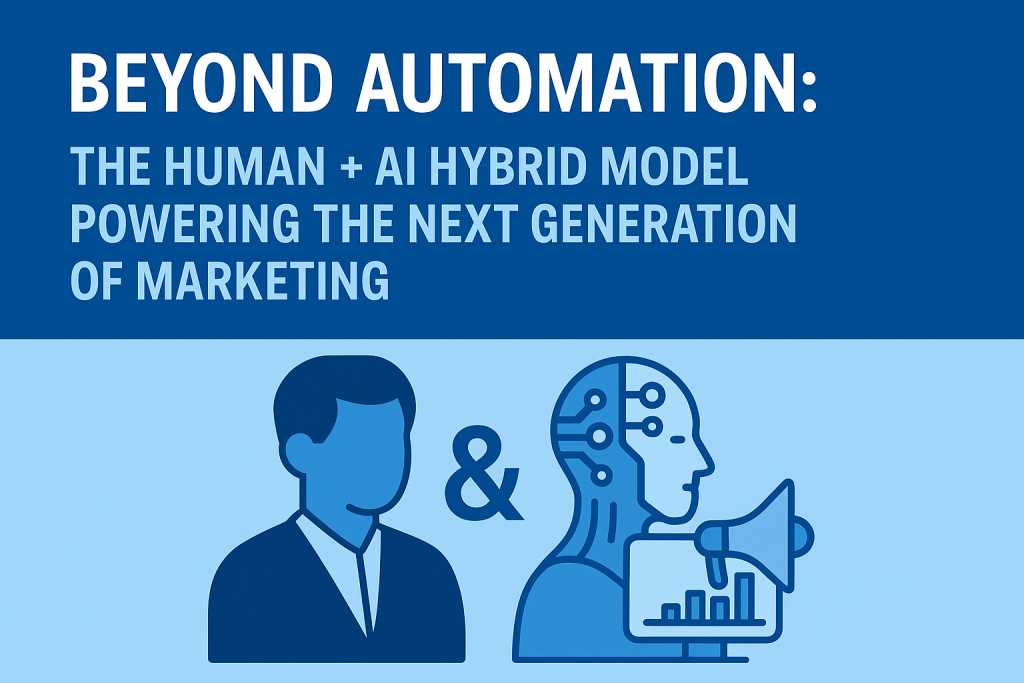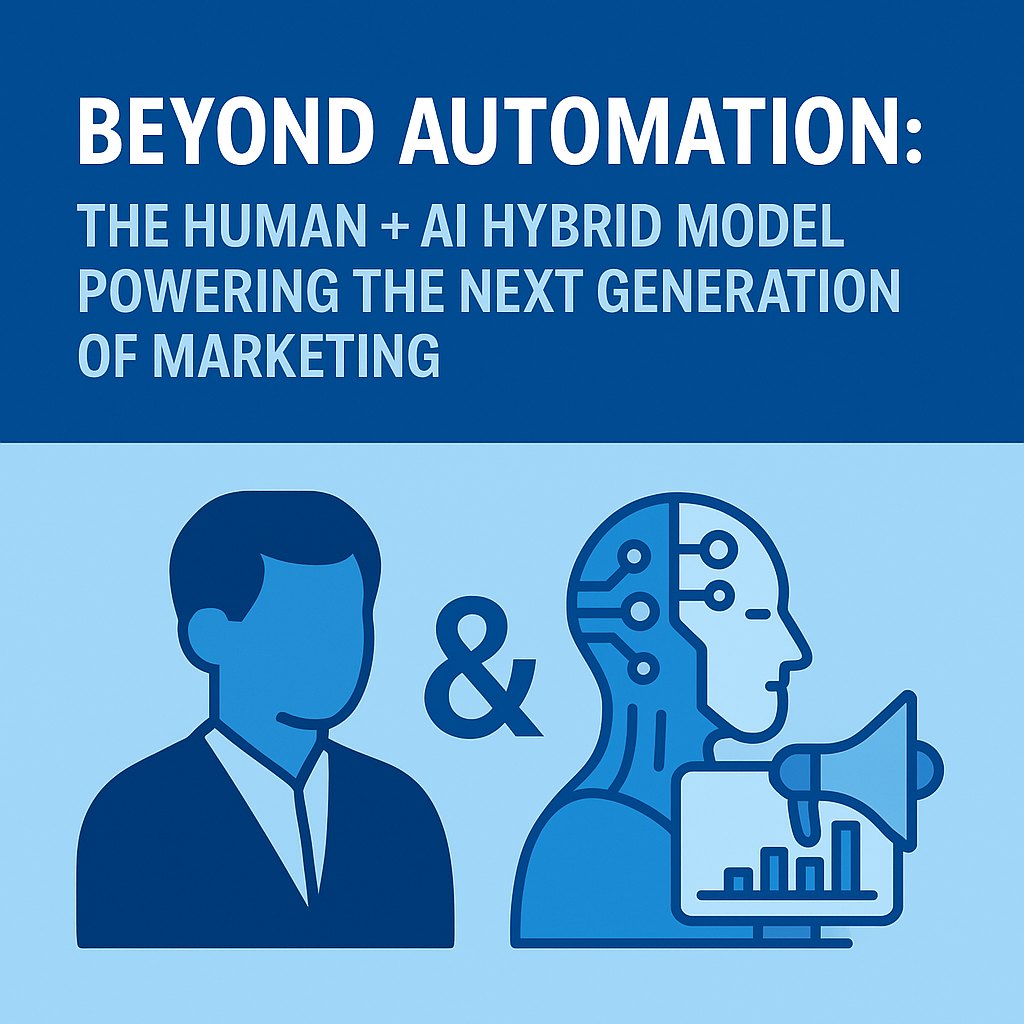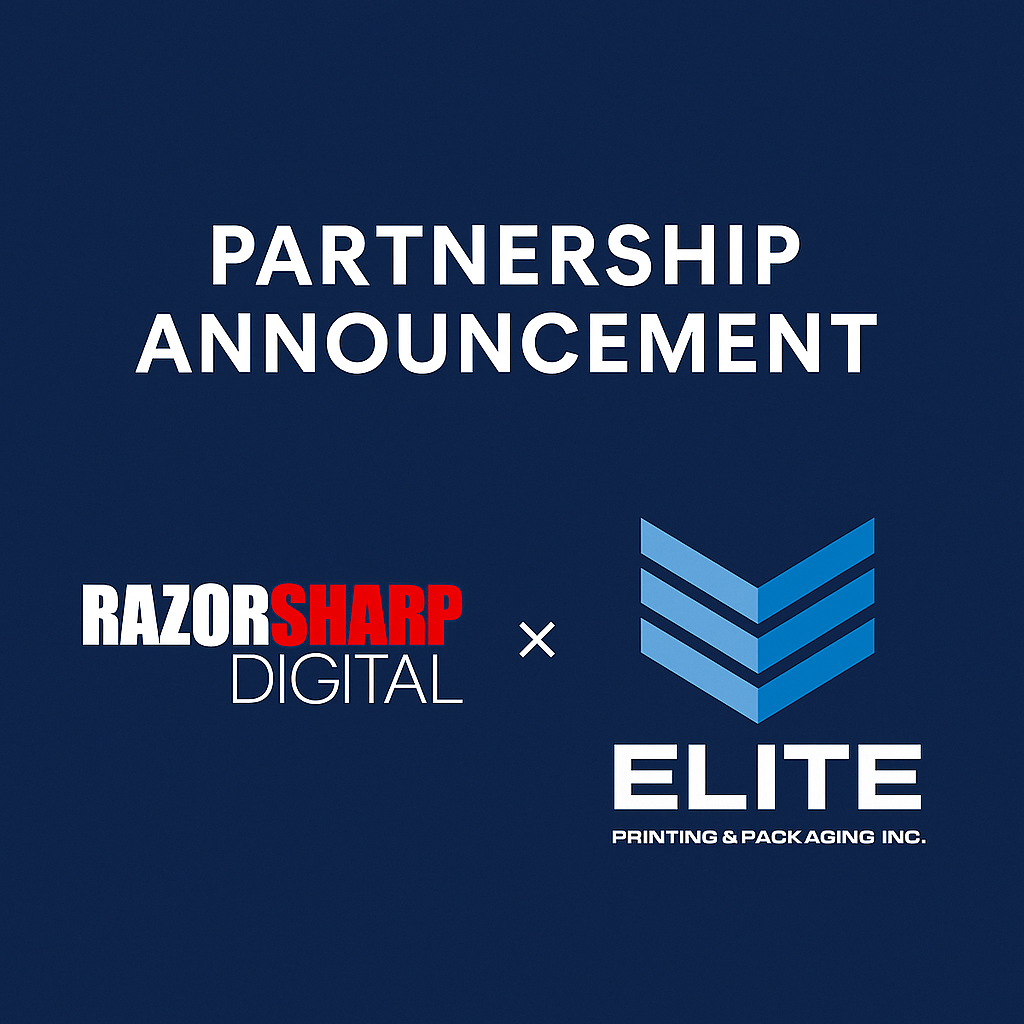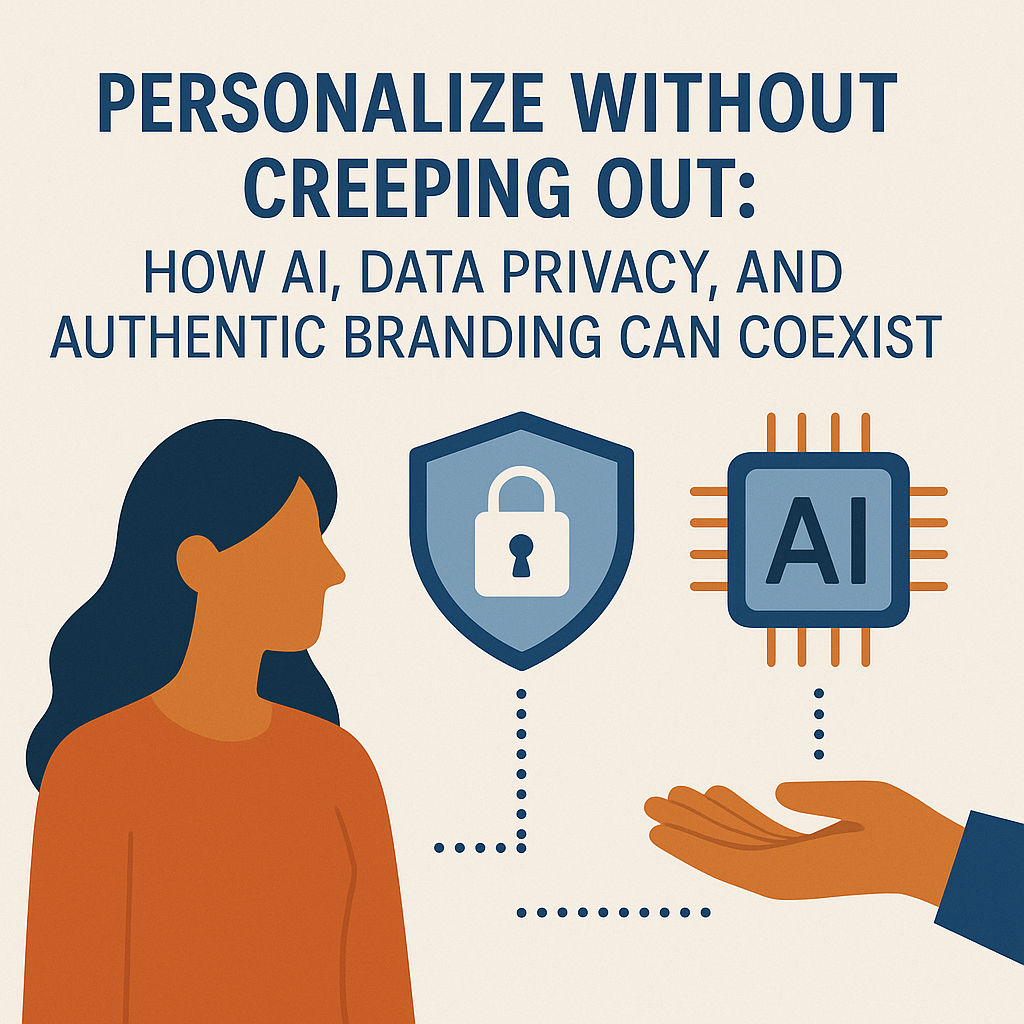In this article we’ll explore:
What the human + AI hybrid model actually means in marketing.
Why this hybrid approach matters now more than ever.
How organisations can build a hybrid model successfully — with practical guidance.
Real-world applications, challenges and the path forward for marketing teams.
1. Defining the Human + AI Hybrid Model in Marketing
When we talk about the human + AI hybrid model, we’re referring to a system where humans and AI work together, each playing to their strengths, rather than machines simply replacing human effort or humans resisting automation.
What AI brings
Speed, scale and pattern-recognition: AI tools can process vast datasets, uncover insights, segment audiences, optimise media buys or generate drafts at pace. sps.nyu.edu+2SpringerLink+2
Consistency and automation: Routine tasks, repetitive workflows, campaign testing and measurement can be handled more reliably by AI engines.
Data-driven decision support: AI can surface predictive insights, identify micro-trends and provide recommendations.
What humans bring
Creativity, empathy and emotional intelligence: Humans craft the brand story, create connections, understand nuance in cultural context and emotional triggers. MarketingProfs+1
Strategic thinking and ethical judgment: Humans set the vision, weigh trade-offs, apply values and make decisions where ambiguity or ethics matter.
Authenticity and trust: In marketing, audiences value human authenticity — a fully automated experience can feel detached or disingenuous.
The synergy (human + AI)
The hybrid model is where the magic happens — AI handles the heavy lifting of data, scale and repeatable tasks; humans intervene where creativity, empathy, relationship-building and strategic judgement are required. For example: AI generates content variations, tests performance, surfaces top performers — then human marketers refine the tone, align with brand values and inject a human voice. sharpinnovations.com+1
A recent study of marketing analytics described this as “hybrid intelligence: human-AI collaboration in marketing analytics” — showing that combining human intuition with AI computational capability improves outcomes. SpringerLink
2. Why the Hybrid Model Matters for Marketing Now
Why is this hybrid model turning from concept into imperative for marketing teams in 2025 and beyond? There are several converging forces:
Rising expectations & complexity
Consumers expect personalisation, real-time engagement, seamless experiences across channels. AI alone can analyse and scale, but often lacks the depth of human insight to craft experiences that feel meaningful. A human-only approach cannot match the speed and scale. The hybrid model is required to meet both demands simultaneously.
Automation alone isn’t sufficient
Many organisations experimented with automation. But lessons show that automation without human oversight can lead to generic messaging, brand dilution or trust issues. For example, the article on customer service warns: AI may handle routine tasks, but lacks empathy and critical thinking — meaning a hybrid human-AI team provides better customer experience. CMSWire.com
Competitive differentiation
As AI adoption grows, the differentiator will not just be that you use AI, but how you integrate it with humans. Organisations that get the human-machine mix right will build stronger customer relationships, deeper brand trust and more agile marketing models. A Forbes piece notes that leading companies like HubSpot are betting on hybrid human-AI teams as “the future of marketing.” Forbes
Trust, ethics and human-centricity
In an age of AI concerns — bias, transparency, “AI washing” — having humans in the loop is a trust-building factor. Customers and stakeholders want to know there is human oversight, that empathy, context and ethics are present. The hybrid model supports this. sps.nyu.edu
Future-proofing roles & skills
Rather than humans being replaced, hybrid models reshape roles: humans move into higher-value work (strategy, creativity, relationships), while machines take over the more routine. This shift helps companies retain talent and stay adaptable. Razor Sharp Digital
3. How to Build the Human + AI Hybrid Model: Practical Steps
Creating a hybrid marketing model is not plug-and-play. It demands strategy, design, culture and continuous iteration. Here are actionable steps:
Step A: Map your tasks & identify hybrid sweet spots
List your marketing value chain: content creation, campaign planning, media buying, customer support, analytics, CRM, etc. For each task consider:
What can AI do (scale, data-crunching, repetitive)?
What only humans can do (emotion, context, creativity, ethics)?
Which tasks are ripe for hybridisation (human + AI working together)?
Step B: Define clear roles & hand-off protocols
Design the workflow: when does AI act, when does human intervene, how do transitions happen? For example, AI may generate first drafts of ads; humans edit and approve; AI tests variations; humans review insights and adapt. Without clear boundaries you risk confusion or a tangled workflow. Razor Sharp Digital+1
Step C: Choose the right tools and architecture
Select AI tools that are not black-box, that allow human oversight, transparency, intervention. Ensure data quality and governance are strong (garbage in = garbage out). Train your teams on how to use AI, interpret outputs, override when necessary.
Step D: Build human skills & culture
Develop “algorithmic fluency”: humans need to understand what AI is doing, its limitations, how to interpret results.
Cultivate humanistic insight: training in empathy, brand storytelling, ethical decision-making remains critical.
Encourage collaboration: humans and AI should be viewed as team-members, not adversaries. Razor Sharp Digital+1
Step E: Measure the right metrics
Don’t just track cost savings or speed. Metrics should include: creativity, engagement, brand sentiment, customer trust, long-term ROI, hybrid interaction quality. Balanced metrics help you avoid over-automating. sharpinnovations.com
Step F: Iterate and scale
Pilot small, learn, expand. Early wins build confidence. Adjust workflow, tech, roles. Over time refine hand-offs, update metrics, evolve culture. Avoid “big-bang” rollouts that overwhelm teams or sour adoption. SpringerLink
4. Use Cases in Marketing: Where Hybrid Works Best
Let’s look at concrete marketing scenarios where a human + AI hybrid model shines.
Content Strategy & Creation
AI scans trends, identifies topics, drafts copy or suggestions.
Humans refine tone, weave brand narrative, create emotionally rich storytelling. This combination speeds production while preserving brand voice. MarketingProfs
Example: a campaign where AI generates multiple headline options; humans pick the best, adapt for culture and nuance.
Campaign Optimisation & Media Buying
AI handles real-time bidding, audience segmentation, adjustment of bids and placements at scale.
Humans monitor brand safety, interpret campaign context, adjust strategic direction or creative based on insights.
The hybrid model allows speed and scale without relinquishing strategic control.
Customer Experience & Support
AI chatbots handle routine inbound queries; humans step in for complex, emotional or high-stakes interactions. CMSWire.com
Humans interpret sentiment, build relationships, handle escalation — while AI provides the groundwork, context and routing.
Analytics & Strategy
AI crunches large datasets, identifies patterns, predicts outcomes.
Humans interpret the “why,” define strategy, make decisions: what to prioritise, what to test, what to invest in. SpringerLink
The human-AI team yields insights that are both deep and actionable.
Brand & Ethical Oversight
AI systems could inadvertently introduce bias, mis-align with brand values or mis-interpret culture.
Humans provide oversight, ensure ethics, authenticity and trust are upheld.
Especially important in marketing where brand perception and customer trust are at stake.
5. Challenges & Mistakes to Avoid
While the hybrid model holds great promise, it’s not without pitfalls. Here are common mistakes and how to avoid them:
Mistake: Over-reliance on AI and losing the human touch
If you automate everything and treat human involvement as optional, you risk generic messaging, poor brand alignment and diminished customer trust. The hybrid model fails if humans are sidelined. sharpinnovations.com
Mistake: Poor data quality or bad governance
AI is only as good as its data. If data is incomplete, biased or ungoverned, AI results will amplify issues. Effective hybrid models build human oversight into data pipelines. SpringerLink
Mistake: Lack of change management & skill-gaps
Introducing new tools without training, culture change or clear roles leads to resistance, confusion and subpar adoption. Hybrid success requires investment in people. Razor Sharp Digital
Mistake: Vague workflows and hand-off confusion
If it’s unclear when AI stops and human starts (or vice-versa), workflows get messy, roles overlap, experience suffers. Clarity is key.
Mistake: Ignoring ethics, transparency and trust
If your hybrid model hides human involvement or lacks transparency, customers may feel mis-led. Building trust is essential for long-term success.
6. The Future of Marketing: Hybrid at the Core
What does the road ahead look like when hybrid human-AI marketing becomes mainstream?
We will see marketing organisations increasingly designed as hybrid teams — humans + AI agents working side-by-side. Forbes
Job roles will evolve: marketers will spend less time on repetitive tasks and more time on strategic, creative, relationship-driven work.
AI tools will become more adjustable, transparent and designed for human collaboration (not black box automation).
Trust, authenticity and human connection will emerge as competitive differentiators as automation becomes table-stakes.
Data and insights will fuel decision making, but the human element will determine which direction to go, how to interpret, and how to connect with real people.
The organisations that thrive will be those that integrate humans and machines thoughtfully—not treat AI as a mere tool or humans as obsolete.
As one research summary notes: the real breakthrough lies in “hybrid intelligence … combining AI’s power with human creativity and empathy.” sps.nyu.edu+1
7. Your Next Steps: Getting Started
If you’re ready to embrace the hybrid model in your marketing organisation, here’s a quick roadmap:
Audit your current workflow: Map all marketing tasks and identify where AI could assist and where human strength is essential.
Pilot a hybrid workflow: Choose a small campaign, apply AI + human collaboration, measure results, learn.
Define roles & escalation paths: Decide which tasks are AI-led, which are human-led, how hand-off happens.
Train your team: Build skills in AI-tool usage, data literacy and human insight techniques.
Monitor and measure properly: Set metrics that capture the value of human-AI collaboration (e.g., engagement, speed, customer satisfaction, brand trust).
Iterate and scale: Use the learnings from pilots to refine process, scale to more functions, embed culture.
Automation isn’t going away — but the future of marketing isn’t about choosing automation or human creativity. It’s about blending the two. The human + AI hybrid model is more than a buzz-phrase: it’s a strategic imperative for marketers who want to scale intelligently, create meaningful customer experiences and stay ahead.
By combining AI’s ability to process data and operate at scale with human empathy, creativity and strategic thinking, organisations will unlock new levels of performance — faster, smarter and more human-centric. The brands that master the hybrid model will be the ones that lead in growth, trust and relevance.
So, ask yourself: How will your organisation blend humans and AI so that each does what they do best? The answer to that question may define marketing success for years to come.










